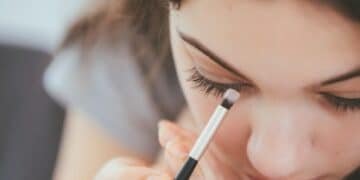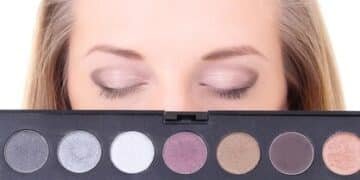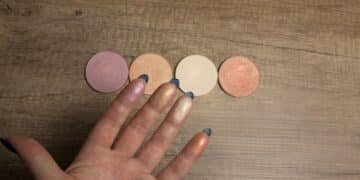Flawless Base 2025: The Ultimate Primer Application Guide

Achieve a flawless base in 2025 by mastering our updated 5-step guide to applying face primer, ensuring your makeup lasts longer and looks impeccable all day long, tailored for the latest trends and product innovations.
Want to keep your makeup looking fresh and vibrant all day long? The secret lies in the perfect application of face primer. Our updated Achieve a Flawless Base: The Updated 5-Step Guide to Applying Face Primer for Long-Lasting Makeup in 2025, will give you the knowledge you need to create a smooth, long lasting base, no matter your skin type.
Why Face Primer is a Must-Have for Flawless Makeup
Face primer is the unsung hero of any makeup routine, it creates a smooth canvas, extends the wear of your makeup, and addresses various skin concerns.
The Benefits of Using Face Primer
Face primer preps your skin and minimizes pores. It prevents makeup from sinking into fine lines.
How Primer Extends Makeup Wear
Primer creates a barrier between your skin and makeup and prevents oil breakthrough.
- Smoothing Texture: Primers fill in fine lines and pores.
- Longer Wear: Makeup lasts significantly longer with primer.
- Oil Control: Some primers control excess oil.
- Hydration: Other primers can infuse moisture into your skin.
Using face primer is essential for achieving a flawless, long-lasting makeup look. By smoothing the skin’s surface, controlling oil, and creating a barrier between the skin and makeup, primer ensures that your makeup stays put all day.

Understanding Different Types of Face Primers
Choosing the right primer for your skin type and concerns is crucial for achieving the best results. Different primers cater to different needs, from hydrating dry skin to controlling oily skin and minimizing pores.
Primer for Oily Skin
Look for mattifying and oil-control primers. These products contain ingredients that absorb excess oil and keep shine at bay throughout the day.
Primer for Dry Skin
Hydrating primers infuse moisture into the skin. These primers typically contain hydrating ingredients like hyaluronic acid and glycerin, which helps to prevent makeup from clinging to dry patches.
- Silicone-Based: Creates a smooth, even surface.
- Water-Based: Lightweight and hydrating, ideal for dry skin.
- Color-Correcting: Neutralizes redness, dark spots, and dullness.
Understanding the different types of face primers allows you to select the perfect for your skin type and makeup goals. Whether you’re looking to control oil, add hydration, or color-correct, there’s a primer designed to meet your needs.
Step-by-Step Guide to Applying Face Primer
Applying face primer correctly can make all the difference in the outcome of your makeup. It is the foundation of a flawless base and getting it right ensures your makeup looks its best.
Step 1: Cleanse and Moisturize Your Skin
Create a clean and hydrated base before applying primer by cleansing and moisturizing. The right cleanser and moisturizer will hydrate without leaving behind residue.
Step 2: Apply a Small Amount of Primer
A little primer goes a long way, and squeezing a pea-sized amount is usually sufficient for the entire face. Focus on the areas that tend to be most problematic, such as the T-zone (forehead, nose, and chin) and any areas with enlarged pores or fine lines.
- Start with clean skin: Always apply primer to clean, moisturized skin.
- Use the right amount: Too much primer can cause pilling or a greasy finish.
- Apply evenly: Ensure the primer is spread evenly across the face.
Mastering the application of face primer involves proper preparation and technique. By cleansing and moisturizing your skin, applying the correct amount of primer evenly, and allowing it to set, you can create a smooth, long-lasting base for your makeup, enhancing its overall appearance and wear time.
Advanced Tips for Using Face Primer in 2025
In 2025, the trends and techniques for applying face primer are evolving. Keeping up with these advancements can help enhance your makeup routine.

Using a Sponge for Primer Application
Applying primer with a damp makeup sponge can help distribute the product evenly and prevent a heavy or cakey finish.
Using a Brush for Primer Application
A foundation brush can provide a more precise application, especially in hard-to-reach areas.
- Hybrid Primers: Combining skincare benefits with makeup prep.
- Targeted Application: Using different primers for different areas of the face.
- Layering Techniques: Combining multiple primers for specific needs.
Staying up-to-date with the latest trends and techniques for applying face primer can significantly improve your makeup routine. Whether it’s using hybrid primers, targeted application, or advanced tools like sponges, embracing these innovations ensures your makeup looks flawless and lasts longer.
Troubleshooting Common Primer Problems
Even with the best primer, problems can sometimes arise. Knowing how to troubleshoot these issues ensures a smooth makeup application.
Primer is Pilling
Pilling can occur if you’re using too much primer or if it’s not compatible with your other skincare or makeup products. Try using less primer and ensuring that your skin is properly exfoliated to remove any dead skin cells that may be causing the pilling.
Primer is Making Skin Greasy
If your primer is making your skin feel greasy, you may be using a formula that’s too rich for your skin type. Switch to a lightweight, oil-free primer designed for oily skin. Ensure that your skincare products are also non-comedogenic and won’t clog pores.
- Incompatible Products: Ensure your primer is compatible with your foundation and moisturizer.
- Incorrect Application Technique: Use the right method for your primer type.
- Skin Sensitivity: Watch out for allergic reactions.
Addressing common problems with face primer ensures a flawless makeup application. By identifying and correcting issues like pilling, greasiness, or incompatibility with other products, you can achieve a smooth, long-lasting base that enhances your overall look.
The Best Face Primers to Try in 2025
As we move into 2025, several new and improved face primers are hitting the market. These products are designed to address a range of skin concerns.
Hydrating Primers
Look for primers that contain hyaluronic acid. Ingredients like glycerin will hydrate the skin without leaving a greasy residue.
Mattifying Primers
Silica and charcoal are great ingredients for mattifying primers because they can absorb excess oil. Look for these ingredients if you have oily skin.
- Innovative Formulas: Exploring new ingredients and technologies.
- Top Brands: Recommendations based on reviews and performance.
- Sustainable Options: Eco-friendly and cruelty-free primers.
Exploring the best face primers available in 2025 ensures you have access to the most innovative and effective products. Whether you need hydration, mattifying, or color correction, selecting the right primer can transform your makeup routine and help you achieve a flawless, long-lasting base.
| Key Point | Brief Description |
|---|---|
| ✨ Primer Benefits | Creates a smooth base, extends makeup wear. |
| 💧 Skin Types | Choose primer based on skin needs (oily, dry). |
| ✅ Application | Apply on clean, moisturized skin; use small amount. |
| 📅 2025 Trends | Hybrid formulas, targeted application. |
Frequently Asked Questions (FAQs)
▼
The main purpose of face primer is to create a smooth base for makeup application. It fills in pores, smooths fine lines, and helps makeup adhere better to the skin, which makes it last longer.
▼
Yes, you can use primer without foundation. It can help to even out skin tone, minimize pores, and control oil, giving your skin a smoother appearance even without any makeup on top.
▼
A small amount of primer is usually sufficient. Start with a pea-sized amount and apply it evenly to your face, focusing on the areas that tend to be most problematic, such as the T-zone.
▼
Primer can cause breakouts if it contains comedogenic ingredients that clog pores. Look for non-comedogenic primers and always remove your makeup thoroughly at the end of the day to prevent breakouts.
▼
Choose a primer based on your skin type. For oily skin, opt for mattifying primers. If you have dry skin, try hydrating primers. For sensitive skin, look for primers free of fragrance and parabens.
Conclusion
Mastery of face primer application is essential for achieving a flawless, long-lasting base in 2025. By understanding the different types of primers, following our step-by-step guide, and keeping up with the latest trends and techniques, you’ll be well-equipped to create a perfect canvas for your makeup, ensuring it looks its best all day long.





